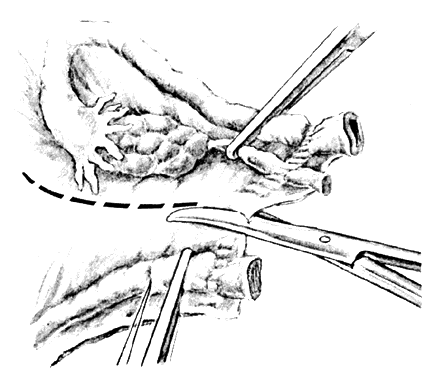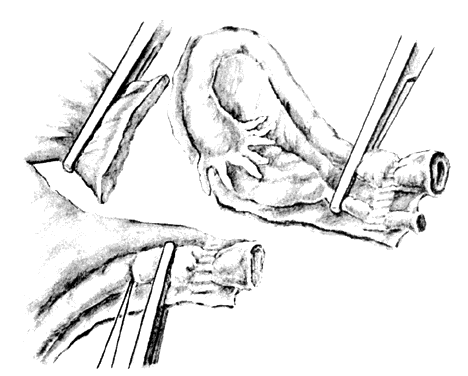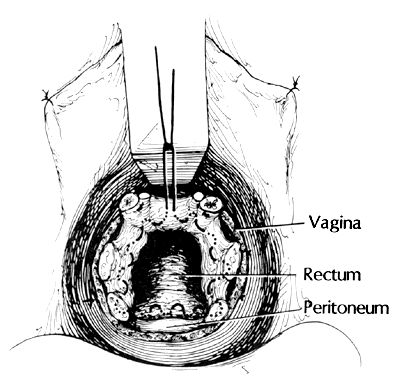The following step-by-step vaginal hysterectomy technique may not be suitable for all surgeons in all circumstances; however, it may be used as a basis on which to build one's own surgical technique. An examination under anesthesia is performed once the patient has been prepared and draped, in dorsal lithotomy position, to assess descensus of the pelvic organs and respective defects, mobility, and uterine size. The final decision is made at this time4 as to whether the procedure may be done vaginally or abdominally. The cervix is then grasped on the anterior or posterior lip with a tenaculum or a vulsellum forceps. Sounding the uterus at this time will help to confirm the suspected size and contour of the uterus found in the office examination and in the examination under anesthesia. Gentle traction in all directions with the vulsellum enables the surgeon to visualize the cervical-vaginal junction, the area where the initial incision will be made. At this time, a paracervical and submucosal injection of 1/2% lidocaine with 1:200,000 or a dilute solution of vasopressin9 may be used to help decrease operative blood loss, decrease postoperative pain, and as some believe, delineate the surgical planes. Areas to be injected include the paracervical tissue, the area around the uterosacral ligaments, the lower portion of the cardinal ligament, and the bladder pillars. The use of vasoconstrictive infiltration is not necessary in all instances. The majority of time, blood loss is controlled with clamps and cautery. I believe that the surgical planes are not made easier to identify by injection. Some believe that the spasm of the small vessels brought on by vasoconstrictive agents may also mask bleeding of a small vessel until the medication wears off, when it shows up as a postoperative hemorrhage. With adequate traction on the anterior and posterior lips of the cervix, a circumferential incision is made through the full thickness of vaginal epithelium at the cervical-vaginal junction (Fig. 1 and Fig. 2). As this is being performed, adequate counter-traction against the respective lateral vaginal wall will prove to be helpful.
|
|
Once the initial incision is made through the full thickness of the vaginal epithelium, the vagina may be dissected sharply from the underlying tissue or may be accomplished with the operator's finger. It is important to remember that this blunt dissection should be done gently so that the tissues being displaced have excellent tactile sensation (Fig. 3 and Fig. 4). If the initial incision is made below the cervical-vaginal junction and too close to the external os, a greater amount of dissection will be needed to displace the vaginal mucosa. In addition, there is usually an increased amount of bleeding when an incision is made too low on the cervix. Therefore, the selection of the level should be at the cervical-vaginal junction, a point that is just below the bladder reflection. Should the initial circumferential incision be made too deep, the dissection extends into the cervix, leading to increased blood loss and technical difficulty. It is most important to dissect through the full thickness of the vaginal epithelium to identify the anterior and posterior cul-de-sac. The next step is entry into the posterior cul-de-sac of Douglas. This can be identified by placing the posterior vaginal mucosa and underlying tissue on stretch with either forceps or sponge over the operator's finger (Fig. 5). Once the posterior peritoneum has been identified, it is grasped with forceps and then opened with scissors (Fig. 6). The incision line is then extended to either side just short of the uterosacral ligaments. An interrupted suture is then placed at the 3, 6, and 9 o'clock positions to approximate the peritoneum to the vaginal cuff, aiding in hemostasis and traction and helping define the peritoneum at the time of vaginal cuff and intra-abdominal closure. Once the pelvic cavity has been opened, an intra-abdominal pelvic examination is performed to rule out any other pelvic disease of the uterus or adhesive disease of the cul-de-sac and adnexa. At that time, the weighted speculum, or a retractor with a long blade (Fig. 7), is placed into the posterior cul-de-sac to help keep the rectum safely out the way during the operation.
|
|
|
|
|
With retraction of the lateral vaginal walls and countertraction on the cervix, the uterosacral ligaments are clamped with the tip of the clamp incorporating the lower portion of the cardinal ligaments, if possible. The clamp is placed perpendicular to the uterine axis, and the pedicle is cut and sutured (Fig. 8). The pedicles taken during vaginal hysterectomy are cut close to the clamps so that there is a decreased chance of their becoming necrotic, sloughing, or providing a culture medium for bacterial infection. When suturing a pedicle, the needle point is placed at the posterior tip of the clamp and passed through the tissue by a rolling motion of the operator's wrist (Fig. 9).
|
|
Once ligated, the uterosacral ligaments may be immediately transfixed to the posterolateral vaginal mucosa (Fig. 10) or held long for use at the end of the case. Either way, the suture is used to help support the vagina to prevent posthysterectomy prolapse, provide hemostasis at the angle of the vagina (a common place for postoperative bleeding), and if done as an initial step, help the surgeons not to cut the sutures accidentally before their transfixation to the vaginal mucosa at the end of the procedure. If the suture is held long, it will help facilitate the location and inspection of all the pedicles at the end of the procedure.
The next step involves deciding whether or not to enter the vesicovaginal space and the anterior cul-de-sac. With downward traction on the cervix, a pair of scissors with the points directed toward the uterus is used to advance the bladder (Fig. 11). Entry into the vesicouterine space will allow the bladder to be displaced upward, helping the ureters to be elevated and displaced somewhat laterally. This helps to pull them away from the midline and aids in the safe exposure of the areas where the uterine arteries will be serially clamped, cut, and ligated. Should the vesicovaginal peritoneal reflection not be easily identified, entry into the space can be delayed. As long as the bladder anatomy has been identified by the operator, there is no danger in doing this as long as it is advanced appropriately. Once the bladder is advanced, a retractor is placed in the midline, holding the bladder out of the operative field. This process proceeds each step during the hysterectomy until the vesicovaginal space is entered.
|
With continued traction on the cervix, the cardinal ligaments are identified, clamped, cut, and suture-ligated. These are attached to the vaginal mucosa as the uterosacral ligaments were to the vaginal mucosa to lend support and aid hemostasis (see Fig. 10).
Continued attention to the bladder is noted. If the anterior cul-de-sac has not been opened with the retractor elevating the bladder and ureters out of harm's way, the bladder is advanced with each step of the hysterectomy. Blunt dissection is commonly used, again remembering to have adequate tactile sensation to the tissue so that blunt trauma does not cause entry into the bladder. Sharp dissection is the treatment of choice in this instance and is also a particularly good choice when the patient has had previous surgery, such as a cesarean section.
The anterior peritoneal fold can be identified before or just after clamping on suture ligation of the arteries. Opening the peritoneal cavity anteriorly should not be done blindly so as to prevent bladder injury. The peritoneum is grasped with forceps, tented, and opened with scissors with the tips, again pointing toward the uterus. A Heaney or a Deaver retractor is then placed, and the peritoneal contents are identified. To reiterate, this retractor serves to elevate the bladder out of the operative field as further pedicles are secured along the uterine arteries and infundibulopelvic ligament (Fig. 12).
|
Contralateral and downward traction is placed in a serial fashion on the cervix. An effort is made to incorporate the anterior and posterior leaves of the vesicouterine peritoneum in the clamp such that the uterine vessels are identified, clamped, cut, and suture-ligated. A single clamp, single suture method is completely adequate. However, in a training institution a two-suture technique has been used. The first is the simple ligature with the second being a Heaney-type transfixation suture. While we are not advocates of double-tying, double-tying of all pedicles throughout the hysterectomy can be performed as long as other structures such as the ureters are identified and kept out of harm's way. The uterus can be removed with the cervix presenting first or by delivering the uterine fundus posteriorly. To assist in the removal of the uterus, a tenaculum is placed on the posterior fundus, in a successive fashion, to deliver the fundus posteriorly. Whether delivering posteriorly or bringing the uterus out with the cervix presentation, the operator's index finger is used to identify the utero-ovarian ligament and to aid in clamp placement. With both the anterior and posterior peritoneum opened, the remainder of the broad ligament and the utero-ovarian ligaments are clamped, cut, and ligated. This pedicle will usually include the round ligament as well, but the round ligament may also be taken as a separate piece (Fig. 13). Double ligation of the utero-ovarian and round ligament complex is preferred, although the single ligation technique can be used. When the twoclamp technique is used, the first clamp is effected with a suture ligature followed by a second suture ligature medial to the first. As stated, this pedicle includes the proximal portions of the round ligament and the fallopian tube, as well as the utero-ovarian ligament. At all times, clamps on the “adnexal pedicle” should be pointed away from the pelvic sidewall toward the midline to avoid having the pelvic sidewall structures at risk during the hysterectomy.
|
The fallopian tubes and ovaries are now inspected by drawing them into the operative field. If the adnexal removal had been a planned step, the round ligaments would have been taken separately as adnexal structures (Fig. 14). Traction is then placed on the utero-ovarian pedicle and the ovary drawn into the operative field with a Babcock clamp. The peritoneum between the round ligament and the fallopian tube is then excised (Fig. 15) with the scissors. This maneuver will separate the fallopian tube and ovary from the round ligament so that the infundibulopelvic ligament can be clamped, cut, and tied (see Fig. 15; Fig. 16). It is entirely appropriate to take the fallopian tube and ovary as separate pedicles to enable good visualization should the ureter or nearby blood vessels be in such a position that they are at risk. This will allow better visualization of the entire sidewall area.
|
|
|
It is my bias that reperitonealization should be performed. I use a permanent suture and begin with the anterior peritoneal edge. A continued purse-string suture is begun at 12 o'clock and continues in a clockwise fashion to incorporate the distal portion of the left upper pedicle and the left uterosacral and cardinal ligaments. The suture then incorporates the posterior peritoneum as high as possible, if not the muscularis of the anterior wall of the rectum. The suture is then carried through the uterosacral and cardinal ligament on the patient's right side, as well as through the right upper pedicle. This type of suture with high peritoneal closure helps to prevent future enterocele formation. It is entirely appropriate to use a delayed, absorbable suture, but I believe that permanent suture should be used to prevent any type of herniation. Our colleagues in general surgery use permanent suture for any type of hernia, and this has become my suture of choice to close off the cul-de-sac (Fig. 17). This type of suture, in essence, creates a posterior culdoplasty of one type as a routine measure to prevent enterocele formation. However, there are other types of culdoplasties that may be used in an attempt to achieve cul-de-sac closure and enterocele prevention. The Halban vertical closure, the modified Moschcowitz procedure through the vagina, and the McCall culdoplasty have all been heralded as methods to help prevent future enterocele formation.
Once cul-de-sac peritonealization has been accomplished, the vaginal mucosa can be approximated in one of several ways: either in a vertical or horizontal fashion, using either interrupted or continuous sutures.10 These sutures will be placed through the entire thickness of the vaginal epithelium, with care taken not to enter the bladder anteriorly. The purpose of the sutures is to obliterate the underlying dead space and to produce an anatomic approximation of the vaginal epithelium. The vaginal cuff may also be left open to promote drainage, helping to prevent blood and serous fluid collection postoperatively.
After the procedure, I prefer to leave an indwelling catheter in the bladder for the first 24 hours, especially if the patient has been under a general anesthetic and will not be moving too much during the initial 24 hours except for turning in bed. In addition, at the end of the procedure I place a vaginal pack soaked with a cleansing solution. The cleansing solution does not decrease infection, but merely makes it easier to place the pack and remove it in the next 24 hours. My feeling, although controversial, is that this pack acts much like any other type of pressure dressing, and will help tamponade any small vessels that may begin to bleed once the dilute vasoconstrictive solutions have worn off. Both urinary catheter and pack are removed 24 hours after the procedure. The following are other indications for postoperative bladder drainage 24 hours after hysterectomy: patient unable to void spontaneously, significant pelvic pain, concurrent vaginal reparative procedures, surgical procedures for stress incontinence, vaginal packing, and patient anxiety.
















